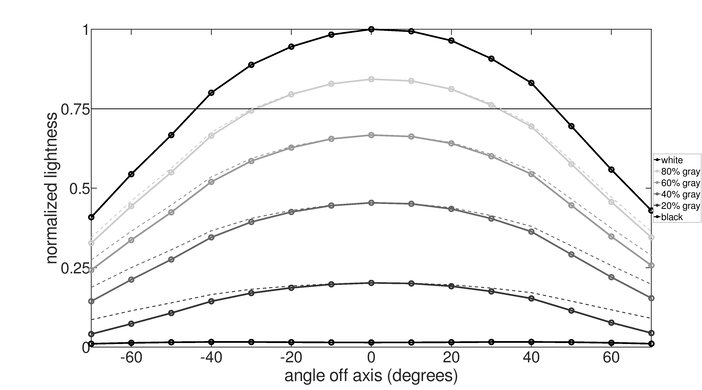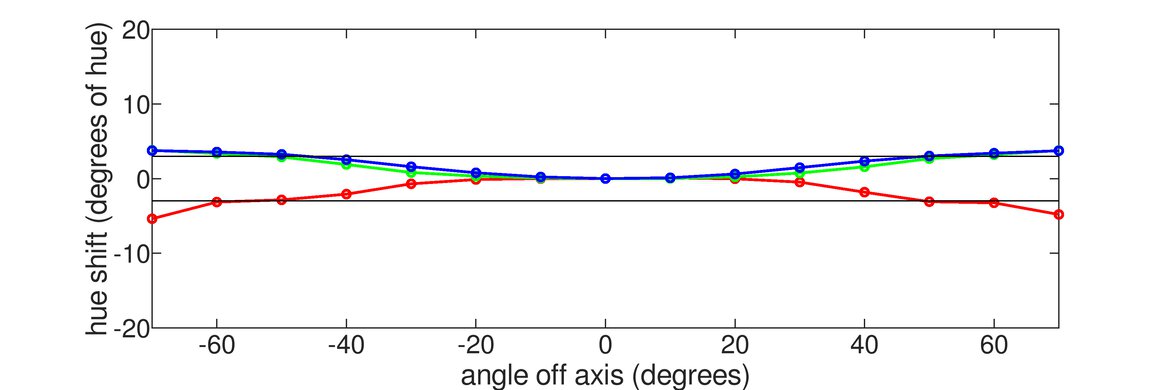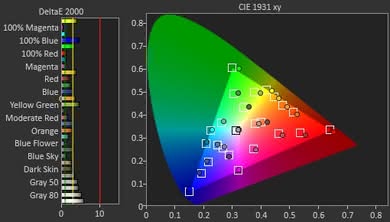Our Verdict
The Dell U2718Q is a good monitor for most uses. It has wide viewing angles and excellent ergonomics, great for use as an office monitor. It's a good basic gaming monitor, but it probably won't please most serious gamers. The high-resolution screen is also great for media creation or watching videos.
- Wide viewing angles.
- Easy to adjust stand with great ergonomics.
- Outstanding gradient handling.
- Poor HDR performance.
- Mediocre black uniformity and visible backlight bleed.
This is a great office monitor. The Dell U2718Q has wide viewing angles, excellent ergonomics, and a great amount of screen real estate. Text is exceptionally clear, and it has excellent uniformity. Although it can get bright enough for most viewing environments, it has mediocre reflection handling, so glare might be an issue in a bright room.
Overall, the Dell U2718Q is a good gaming monitor, but it likely won't please serious gamers. It has low input lag and good response time, resulting in little blur behind fast-moving objects. Unfortunately, it's limited to a 60Hz refresh rate and it doesn't support any advanced gaming features.
The Dell U2718Q is a good monitor for multimedia. The high-resolution screen is great for watching the latest movies in 4k, and the wide viewing angles are great for watching the latest videos with a group of friends. Unfortunately, it has mediocre reflection handling, so glare might be an issue in a bright room.
The Dell U2718Q is a great monitor for media creation. The high-resolution screen allows you to see more of your work at once, and it has outstanding ergonomics and wide viewing angles. It also has excellent uniformity, decent accuracy out of the box, and outstanding gradient handling. Unfortunately, it has mediocre reflection handling, so glare might be an issue in a bright room.
Overall, the Dell U2718Q is a decent monitor for HDR gaming, thanks to the low input lag and good response time. Although this monitor technically supports HDR, there's little benefit to it, as it can't get very bright in HDR, can't display a wide color gamut, and it has a low contrast ratio.
Changelog
- Updated Nov 25, 2020: Fixed an error with the weight.
- Updated Jun 11, 2020: We corrected a minor mistake in the Refresh Rate scoring.
- Updated Feb 17, 2020: Converted to Test Bench 1.1.
- Updated Aug 08, 2018: Review published.
Check Price
Differences Between Sizes And Variants
We've tested the 27" U2718Q, which is the only size available.
If someone comes across a different type of panel or if their Dell U2718Q doesn't correspond to our review, let us know and we'll update the review. Note that some tests such as the gray uniformity may vary between individual units.
The U2718Q we reviewed was manufactured in May 2018 (Revision A03).
Popular Monitor Comparisons

The Dell U2718Q is a very good IPS monitor, and one of the best work monitors we've tested, but there are better alternatives out there, especially if you want decent HDR performance. See our recommendations for the best monitors, the best monitors for dual setup, and the best 4k gaming monitors. See also our recommendations for the best mice and the best keyboards.
The Dell U2720Q is a 2020 refresh of the Dell U2718Q. Aside from some slight differences in their outer design and the added USB-C ports on the U2720Q, both monitors offer identical features. Performance is largely the same as well, although the U2720Q has a higher peak brightness, better SDR and HDR color gamuts, and it also has better reflection handling. However, the U2718Q has a faster response time and lower input lag.
The Dell U2718Q is better than the Dell U2719D. The U2718Q supports HDR, although this doesn't add much, and it has better vertical viewing angles. The U2718Q also has better black uniformity and has a higher resolution screen. On the other hand, the Dell U2719D has a flicker-free backlight.
The Dell U2718Q is better than the Dell U2717D. The Dell U2718Q has a higher native contrast ratio and supports HDR, as well as having a higher resolution screen that allows you to see more details or get more done. The U2718Q has much lower input lag regardless of input resolution, great for gamers. The Dell U2717D has no visible flicker and better reflection handling.
The Dell U2718Q is better than the Dell U2715H. The Dell U2718Q supports HDR and performs decently in that mode. It also has a 4k resolution so you can display more details of your work on the screen. Finally, the Dell U2718Q has a better black uniformity, which is great in dark scenes, and perfect gradient performance with no visible banding.

We buy and test more than 30 monitors each year, with units that we buy completely on our own, without any cherry-picked units or samples. We put a lot into each unbiased, straight-to-the-point review, and there's a whole process from purchasing to publishing, involving multiple teams and people. We do more than just use the monitor for a week; we use specialized and custom tools to measure various aspects with objective data-based results. We also consider multiple factors before making any recommendations, including the monitor's cost, its performance against the competition, and whether or not it's easy to find.
Test Results

Update 11/25/2020: We incorrectly listed the weight as 8.2 kg without the stand and 13.8 kg with the stand, when those values are the weight in pounds. The review has been updated.
The Dell U2718Q has a simple design, with very slim bezels on all four sides. The stand is simple, supports the monitor well with little wobble, and has excellent ergonomics.
The back of the monitor is clean smooth, very similar to all other Dell monitors. There's a single hole in the bottom of the stand for cable management.
This monitor doesn't support local dimming. The video is provided for reference only.
Good peak brightness levels with negligible variation depending on content. The monitor is bright enough for most rooms, but it can't overcome direct glare.
Mediocre HDR peak brightness. Real scene performance is slightly brighter than in SDR and the U2718Q performs well in most rooms. The brightness varied greatly during our testing, as the monitor appeared to boost the brightness of certain windows but then drop off the brightness after some time (see here). The posted results represent the most consistent results we could achieve (see here).
HDR is only supported when connected via HDMI.
If you want a monitor that has a higher HDR peak brightness, check out the Dell U2720Q, which is the successor of this monitor.
The Dell U2718Q has very good horizontal viewing angles. This makes it a great choice if you often share the screen with someone else, or if you like to sit close.
Decent vertical viewing angles. Someone looking at the monitor from above might notice a slight decrease in brightness but shouldn't notice much else.
The Dell Ultrasharp U2718Q has excellent gray uniformity, with very little dirty screen effect, but the edges of the screen are noticeably darker than the rest. Sports fans shouldn't notice any issues when streaming games online, and there won't be any darker areas when browsing websites with large white areas.
Decent out-of-the-box accuracy. The white balance is off a bit, causing some noticeable inaccuracies in brighter shades of gray. Most colors are displayed accurately, and gamma almost follows the sRGB target curve, but some scenes are darker than they should be.
After calibration, the Dell Ultrasharp U2718Q has outstanding accuracy. Any remaining inaccuracies aren't noticeable, and gamma follows the sRGB color space almost perfectly.
You can download our ICC profile calibration here. This is provided for reference only and shouldn't be used, as the calibration values vary per individual unit even for the same model, due to manufacturing tolerances.
The Dell Ultrasharp U2718Q has excellent color volume in SDR. Adobe RGB coverage is limited by the poor color space coverage and isn't as good as other HDR monitors we've tested, like the Samsung CHG70.
Unfortunately, the Dell U2718Q has poor color volume in HDR. It's severely limited by the color gamut, and it can't produce dark saturated colors very well. Note that HDR is only supported over HDMI on this monitor.
Unfortunately, the Dell U2718Q has mediocre reflection handling. Reflections aren't diffused as much as the U2717D and they may be distracting.
| Trace Free | Response Time Chart | Response Time Table | Motion Blur Photo |
| Normal | Chart | Table | Photo |
| Fast | Chart | Table | Photo |
This monitor has a very good response time, but there's more noticeable motion blur than high refresh rate gaming monitors. The 'Normal' overdrive setting produces the best results. If you want a faster response time, you can set the response time to 'Fast', but this introduces significant overshoot.
| Trace Free | Response Time Chart | Response Time Table | Motion Blur Photo |
| Normal | Chart | Table | Photo |
| Fast | Chart | Table | Photo |
The Dell U2718Q only supports a 60Hz refresh rate, so these results are the same as the 'Response Time @ Max Refresh Rate' test. This monitor has a very good response time, but there's more noticeable motion blur than high refresh rate gaming monitors. The 'Normal' overdrive setting produces the best results. If you want a faster response time, you can set the response time to 'Fast', but this introduces significant overshoot.
The Dell U2718Q uses a dual PWM flicker to dim the backlight. There's a 10kHz flicker that's always present, but this flicker is not visible at all. There's a secondary flicker at 650Hz, but due to the secondary wave, the backlight doesn't completely shut off and the flicker isn't noticeable under most conditions.
There's no optional black frame insertion feature on this model.
Update 06/11/2020: There was a minor mistake in our scoring; it's been updated, but this has caused the refresh score to decrease a bit.
The Dell Ultrasharp U2718Q has a basic 60Hz refresh rate, which is common for 4k monitors. Most people won't have any issue with this, but gamers might be disappointed by the low refresh rate and lack of gaming-oriented features like FreeSync or G-SYNC.
If you want a monitor that supports VRR, check out the Dell S2721QS.
The Dell Ultrasharp U2718Q has excellent input lag, great for office use or even for most gamers.
This monitor has a very sharp 4k UHD resolution, which is excellent for almost any use.
Two of the USB ports support USB 1.2 BC fast charging, and there's an option to power the USB ports even when the monitor is in standby.
The Dell Ultrasharp U2718Q can be used as a USB hub. The USB ports can be left powered when the monitor is off, and two of the ports support BC1.2 fast charging, with a maximum capacity of 2A.


















































